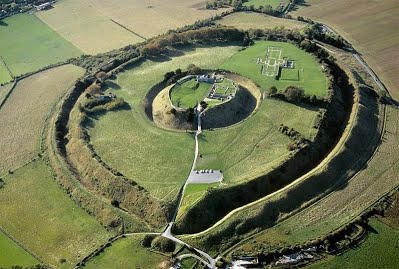
No. 537 DECEMBER 2015 Edited by Don Cooper
Doesn’t time go quickly, here we are in the middle of November looking forward to that end-of-year holiday period again!! Do the years go faster as we get older? It seems like only yesterday that I edited last December’s one!
May I, on behalf of the HADAS community, wish you and yours the compliments of the season and a healthy, happy and prosperous 2016.
HADAS DIARY
Tuesday 12th January, 8pm. Royal Palaces of Enfield. Lecture by Ian Jones (EAS)
Tuesday 9th February, 8pm. Medieval Middlesex – The Archaeological Remains by Adam Corsini.
Tuesday 8th March, 8pm. The Crossrail Archaeology Project. Lecture by Jay Carver.
Tuesday 12th April 2016, 8pm. In the lift to the beach: a visit to the Lundenwic waterfront by Douglas Killock
Tuesday 10th May, 8pm. Hadrian’s Wall: Life on Rome’s northern frontier. Lecture by Matt Symonds.
Tuesday 14th June 2016 ANNUAL GENERAL MEETING
Tuesday 11th October 2016 To be arranged
Tuesday 8th November 2016, 8pm. The Cheapside Hoard. Lecture by Hazel Forsyth
All the above events, unless otherwise stated, will be held at Stephens House & Gardens (formerly Avenue House), 17 East End Road, Finchley N3 3QE, starting at 8pm, with tea/coffee and biscuits afterwards. Non-members are welcome (£1.00). Buses 82, 125, 143, 326 and 460 pass nearby. Finchley Central Station (Northern Line) is a short walk away.
Church Farm House by Don Cooper
Church Farm House, Hendon (formerly Church Farm House Museum) is STILL vacant. The museum was closed in March, 2011, so it won’t be long until the 4th anniversary of its closing. We are being assured by Barnet Council that it is secure and being properly maintained and Historic England have not felt it necessary to add it to the buildings-at-risk register published last month (October 2015). Negotiations, we are told, are proceeding with Middlesex University but have yet to result in the signing of a lease.
Recent discoveries about Roman Britain By Peter Pickering
On 7th November I went to a conference organised by the Roman Society and the Association for Roman Archaeology. There were four lectures describing very recent excavations with remarkable new discoveries from Roman Britain. One was of a late Roman temple site in south-west Wiltshire, with a spectacular set of finds, especially miniature amphorae and hammers, and a large number of coins, over 30 of which have iron nails in them – perhaps originally attached to pieces of cloth, or hammered into a wooden post. There are also some lead curse tablets. But no indication, as yet, of what god or gods might have been worshipped there.
Professor Michael Fulford took us over the eighteen years of his excavation of part of Insula
IX of Silchester, which has finally come to an end, discovering so much more than the Society of Antiquaries had been able to find at the turn of the nineteenth and twentieth centuries. We were all fascinated by the evidence of a flourishing business of skinning dogs, presumably to make fur cloaks – a knife was found carved with an image of mating dogs. It seemed at the end that Professor Fulford was weaning himself and his students slowly from the excavation, having done some work on another insula, re-excavating some of the trenches of the Society of Antiquaries.
Sam Moorhead then gave an account of the Romans west of Exeter.
Although he was standing in for a lecturer who had been prevented from telling us about Binchester, the ‘Pompeii of the North’, no-one would have guessed this from his polished and fluent presentation. The discovery of the site at Ipplepen was due to two active and responsible metal detectorists (who recorded the GPS data for the many coins they found). The coins demonstrated that the Romans had not lost interest after they got to Exeter; geophysical surveying and excavation has already found many archaeological features over several acres, including a roadside cemetery. The dig has a strong community focus. Finally, Andrew Birley told us about the most recent work at Vindolanda, which continues to be one of the most important Roman sites in the country. He is the third generation of Birleys to work there. Among the finds he described were a gold coin of Nero, and the wooden toilet seat. The anaerobic conditions in parts of the site continue to reveal wooden writing tablets and other things which are usually lost. It looks as if the Vindolanda excavations will continue for many years.
The Sandridge Hoard by Jean Lamont
Members of HADAS may be interested to know that the Sandridge Hoard has now been conserved and has gone on display at the Verulamium Museum in St Albans. The Museum is open all year round and every day (Monday to Saturday from 10.00 to 17.30 and Sunday from 14.00 to 17.30), for public holidays such as Christmas check with the Museum, tel. 01727 751 810.
The Sandridge Hoard consists of 159 gold solidi and is the largest collection of solidi ever found in this country: they date from 375-408 AD and represent more wealth than most people could earn in a lifetime. There is no trace of the original container. The guidebook suggests a connection with one of the local villas and mentions Turnershall Farm a few miles away, itself subject of a separate display. Well worth a visit.
http://www.stalbansmuseums.org.uk/verulamium/ Website gives details of entrance fees / parking etc
Lyndhurst Trip – continued
Our aim on our trips is to visit a variety of places without spending too long on the coach. These cover a range of interests, with twenty of our travellers submitting interesting newsletter contributions about our stops, and related topics. Our thanks to all who have put pen to paper.
Day 2 started with one of our longer excursions – one hour to Stonehenge.
Visit to Stonehenge Liz Gapp
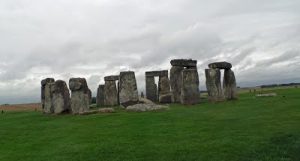 Our coach dropped us at Stonehenge in time for entry timed for 10.30. As the threatened rain was holding off, most of us decided to get the shuttle bus to visit the monument first, before visiting the visitor centre. Some people walked the 1¼ miles to the site; some later also walked back.
Our coach dropped us at Stonehenge in time for entry timed for 10.30. As the threatened rain was holding off, most of us decided to get the shuttle bus to visit the monument first, before visiting the visitor centre. Some people walked the 1¼ miles to the site; some later also walked back.
We had all been provided with audio tour guides. There were numbers on the site which went from 1 to 8 corresponding to the audio descriptions. These descriptions also gave additional numbers for more detailed information about specific aspects. The descriptions pointed out that Stonehenge is the only stone circle with lintels; there are 300 later mounds around the circle using it as a focal point; the monument is not a true henge as the ditch is inside the defensive mound, not outside it; it was all built over a period dating 3,000 – 2,000 BC; the famous bluestones reputedly from the Preseli Hills in Wales are the smaller of the upright stones, the larger ones being the Sarsen stones from a more local area, most likely the Marlborough Downs in North Wiltshire; the stones had been rearranged at various times in the past. As you walk round the circle of the monument various features such as the Heel Stone and the Slaughter Stone are described. You are kept to the edge of the monument by barriers, as the archaeology inside the barriers is deemed too fragile to be walked on.
Talking to people who knew the site from previous visits, it was felt the new approach, whether by shuttle bus or foot, was more atmospheric and a good way to enter the landscape.
After returning to the interpretive centre (around midday), we went to the café and ate our lunch. Then we went to the exhibition, not large but with quite a few interesting video displays. After this we briefly walked round the reconstructed village of round houses. There we also saw two sample bluestones and a Sarsen stone, the latter in a frame to enable it to be moved. This was so that it was possible to feel the difference between the two stone types. The Sarsen frame was set up with a challenge for people to try and move it, with pressure gauges to highlight how much effort it would take to move it, and showing that in practice it would have taken 200 people to move it.
We returned to the coach just after 13.00, although it wasn’t due to depart until 13.30. We were lucky, the rain had held off until just as we were due to leave the site, despite forecasts predicting an earlier start to the rain. Although not the warmest, it was a very enjoyable and rewarding visit.
Old Sarum Peter Nicholson
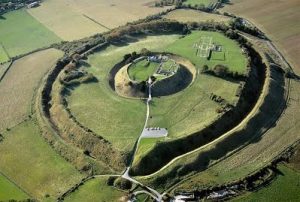 The grey skies which had threatened, but mercifully held off during our visit to Stonehenge began to rain at a sprinkle on the coach trip to Old Sarum, then dampened us more and more. This curtailed both the time we spent on site and the proportion of it we explored.
The grey skies which had threatened, but mercifully held off during our visit to Stonehenge began to rain at a sprinkle on the coach trip to Old Sarum, then dampened us more and more. This curtailed both the time we spent on site and the proportion of it we explored.
The boundaries of the site are those of an Iron Age hillfort probably from about 400 BC.
When the Normans arrived, ready-made defences seemed a bonus too good to ignore and William the Conqueror raised a motte and bailey castle inside in about 1070. Our access was easy – the coach park is in the outer bailey, so no need to climb a hill as at Danebury. The view in front of us was impressive. A deep ditch was crossed by a modern wooden bridge and, rising above us, the inner bailey with rubble cores of walls of extensive ranges of buildings remaining.
Besides castles, the Normans were great cathedral builders and, at Old Sarum, they built two in quick succession inside the hill fort. The first, begun about 1075 was small by their standards with three apses at the east end. The second, larger, cathedral is shown by the rubble cores of its walls, which remain to a little above ground level. The wall lines of the first cathedral, where they do not coincide, are shown by lines of modern paving.
Time moved on and so, unusually, did the cathedral. A hilltop site exposed to extremes of weather and inconvenient for trade had obvious disadvantages. Proximity to a Royal castle, which was politically advantageous in the eleventh century, had ceased to be so in the thirteenth when the Pope had excommunicated the King. After years of dissatisfaction and discord, the foundation stone of the present cathedral, on its site in the river valley below, was laid in 1220. After the cathedral went downhill, literally, Old Sarum did so metaphorically, suffering depopulation, and eventually became notorious as one of the rottenest of rotten boroughs.
Lyndhurst
With the inclement weather, we opted to return to the hotel. The rain having relented, it gave an opportunity for a brief walk around Lyndhurst itself. The town is quite small, with roads that do not lend themselves to modern traffic with frequent queues of traffic for some 400 yards from the traffic lights onto the High Street. Our hotel was at the northern end of the town opposite some open ground.
Race Course View by Vicki Baldwin
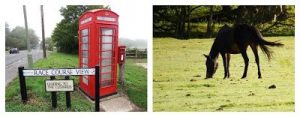 Although the ‘view’ is now open ground where the New Forest ponies come to graze, in the 18th Century there really was a popular racecourse here that appears on contemporary maps and continued in use until the 1880s.
Although the ‘view’ is now open ground where the New Forest ponies come to graze, in the 18th Century there really was a popular racecourse here that appears on contemporary maps and continued in use until the 1880s.
The Custards Vicki Baldwin
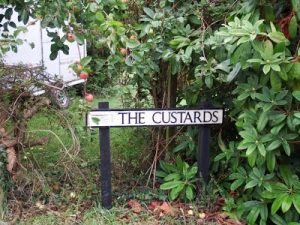 Opposite the hotel a turning, Race Course View, had a sign stating that it led to The Custards, which turned out to be a rather unremarkable road with houses on either side. It seemed a very strange name so I started to look on-line for an explanation. The reason given on the website for ‘Rhubarb Cottage, The Custards, Lyndhurst (I know, I know!) was that there had been orchards on the site and the apples were eaten with custard. This seemed rather an odd link until I remembered that there was a variety of cooking apple named Costard. It would seem rather more logical that ‘The Custards’ is a corruption of ‘The Costards’ and these were the apples grown in the orchards.
Opposite the hotel a turning, Race Course View, had a sign stating that it led to The Custards, which turned out to be a rather unremarkable road with houses on either side. It seemed a very strange name so I started to look on-line for an explanation. The reason given on the website for ‘Rhubarb Cottage, The Custards, Lyndhurst (I know, I know!) was that there had been orchards on the site and the apples were eaten with custard. This seemed rather an odd link until I remembered that there was a variety of cooking apple named Costard. It would seem rather more logical that ‘The Custards’ is a corruption of ‘The Costards’ and these were the apples grown in the orchards.
Report on HADAS Lecture – October 2015 by Ken Sutherland-Thomas Scientific Methods in Archaeology.
Lecture by Dr Caroline Cartwright from Department of Scientific Research at the British Museum.
The speaker’s primary areas of scientific expertise were identification and interpretation of organics such as wood, charcoal, fibres and other plant remains, shell, ivory and bones from all areas and time periods in the British Museum’s collections. She has led expeditions in many parts of the world.
The quite technical talk was illustrated with digital images of many of the objects under investigation. The many techniques used in analysis and investigation were discussed. She highlighted the fact that the processes used for this apply pre-excavation, during excavation and post-excavation as well as in conservation. Also highlighted was the need for outreach with emphasis on the requirement to publish results in an understandable form both in print and online; and to stage exhibitions.
The advance in analysis techniques including ever more sophisticated microscopes in the last couple of decades has been phenomenal and the hardware and software required mean an expenditure of many millions of pounds. Very few organisations can afford this expenditure.
The storage and archiving of objects is important as future techniques not yet discovered may well enable more information to be extracted from these objects.
The meeting, which was well attended, concluded with a question and answer session. Dr Caroline Cartwright was thanked for a very interesting lecture.
CROSSRAIL at Liverpool Street
We have a lecture in March 2016 on the Archaeology discovered during the Crossrail project. Here is a taster from the Crossrail website
http://www.crossrail.co.uk/sustainability/archaeology/liverpool-street/
The Bedlam burial ground was in use from 1569 to at least 1738, spanning the start of the
British Empire, civil wars, the Restoration, Shakespeare’s plays, the Great Fire of London and numerous plague outbreaks. 2015 marks the 350th anniversary of London’s last Great Plague in 1665 and archaeologists hope that tests on excavated plague victims will help understand the evolution of the plague bacteria strain.
The Bedlam burial ground, also known as Bethlem and the New Churchyard, is located at the western end of Liverpool Street. Over 20,000 Londoners are believed to have been buried at Bedlam between 1569 and 1738. It got its name from the nearby Bethlehem Hospital which housed the mentally ill, although only a small number of Bedlam residents are believed to have been buried there.
In June last year Crossrail invited 16 volunteers to scour parish records from across the capital to create the first extensive list of people buried at Bedlam.
The resulting database of over 5,300 names and backgrounds is published on the Crossrail website and will inform Crossrail’s archaeological excavation.
The Roman remains that archaeologists uncovered at the Liverpool Street station tell a very different story from the Bedlam burial ground skeletons. Initially, skulls found in a small river channel were interpreted as wash-out from a Roman cemetery somewhere upstream. But the discovery in May 2015 of a reused cooking pot full of cremated human bones changed archaeologists’ minds…..
Be sure and put a note in your diaries for what I’m sure will be an exciting lecture.
A Member’s Lecture by Don Cooper
Stewart Wild is giving a lecture to the Mill Hill Historical Society at Trinity Church, Mill
Hill Broadway, on 13th January 2016 at 14.30 to 16.00 on the following subject: “History of Stevens’ ink and its Finchley connection”
Other Societies’ Events by Eric Morgan
Thursday, 7th January 2016 at 10.30 am. Pinner Local History Society, Town Hall, Chapel
Lane Car park, Pinner. “Memories of the Queen’s Coronation.” a talk by Terry Jenkins. Visitors £2, Please note the earlier time.
Monday, 11th January 2016, at 15.00 Barnet Museum and Local History Society, Church House, Wood Street, Barnet (opposite Museum). “Photographic History of Charing Cross Road.” Talk by Bob Kayne. Visitors £2.
Wednesday, 13th January 2016 at 19.45 Hornsey Historical Society, Union Church Hall, Corner Ferme Park Road/Weston Park N8 9PX. “The Friern Hospital Story.” Talk by David
Berguer (Chair, Friern Barnet and District Local History Society). Visitors £2 Refreshments.
Friday, 15th January 2016, at 19.00 City of London Archaeological Society (COLAS), St Olave’s Church Hall, Mark Lane, EC3R 7BB. “The Temples and Gods of Roman London.” Talk by Dominic Perring (Institute of Archaeology University College London). Visitors £2.
Thursday, 21st January, 2016 at 19.30 Camden History Society, Venue details not yet available. “Dinosaurs in Crystal Palace Park.” Talk by Professor Joe Cain. Visitors £1. Further details, visit www.camdenhistorysociety.org or Telephone Mrs. Jane Ramsay on 0207586 4436 (acting secretary)
Thursday, 28th January 2016, at 14.30 Finchley Society, Drawing Room, Avenue House, (now Stephens’ House and gardens) East End Road, N3 3QE. “Women and Medical Care in the First World War.” Talk by Dr. Susan Cohen. Non-members £2, refreshments (Please notice earlier time.
Acknowledgements
Thanks to our contributors: Peter Pickering, Jean Lamont, Vicki Baldwin, Ken Sutherland-Thomas, Liz Gapp, Peter Nicholson and Eric Morgan.

